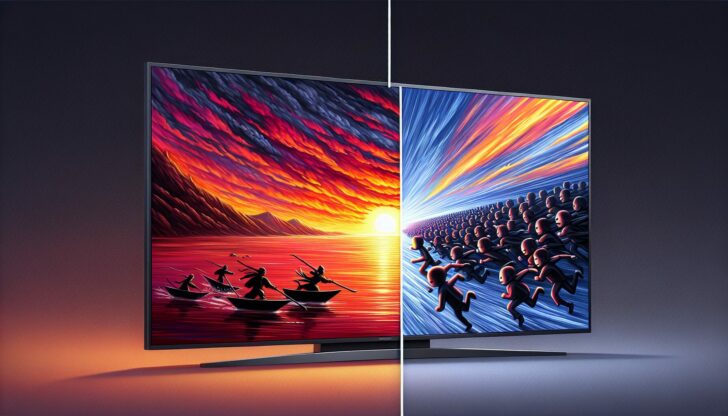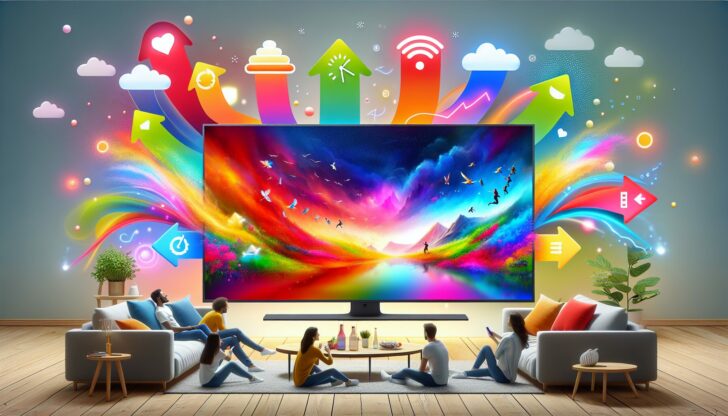Wondering if a plasma screen TV is right for you? This guide explores their key benefits, drawbacks, and how they stack up against LCDs. Find out everything you need to know before making a decision.
Table of Contents
Key Takeaways
Plasma screen TVs offer exceptional picture quality with deep blacks and vibrant colors, making them ideal for immersive home entertainment experiences.
Despite their advantages, plasma TVs face challenges such as higher power consumption, screen burn-in risks, and declining market relevance due to advancements in LCD technology.
When purchasing a plasma TV, consider factors such as screen size, resolution, refresh rate, and warranty options, as maintenance and availability of spare parts may pose challenges.
How Plasma Screen TVs Work

Plasma screen TVs rely on plasma science and advanced electronics. They use a gas mixture, usually neon, xenon, or helium, which becomes electrically conductive with free-flowing ions and electrons when voltage is applied. This interaction releases photons as ultraviolet light, which then hits phosphors on the screen, turning it into visible light.
Each pixel on a plasma screen consists of tiny cells filled with ionized gas, grouped into red, green, and blue clusters. The electric field ionizes the gas, causing it to emit visible light and ultraviolet light, which then excites the phosphors to produce vibrant colors and images.
Plasma TVs create moving images through sophisticated circuitry that controls subpixel discharge in sequence. This allows for smooth transitions and high refresh rates, ensuring fast-paced content like sports and action movies are displayed with exceptional clarity and fluidity.
Evolution of Plasma Screen TVs
The journey of plasma screen TVs began with a vision to enhance display quality for computer-based education. In 1997, Fujitsu unveiled the first plasma screen, marking a significant milestone in display technology. These early models were initially priced at a staggering $20,000, reflecting their cutting-edge nature. However, as production scaled up, the prices gradually became more accessible.
After Fujitsu, manufacturers like Philips and Pioneer entered the market, driving the adoption of plasma TVs. These screens gained popularity due to their large sizes and superior image quality over CRT televisions, meeting the demand for enhanced home entertainment.
Plasma TVs replaced CRT technology in many homes due to their thinner designs and higher definition. They provided larger screen sizes and enhanced viewing experiences with higher refresh rates and vibrant colors. However, competition from LCD and LED technologies eventually shifted market dynamics.
Picture Quality and Performance

Plasma screen TVs are known for their exceptional picture quality, delivering deep blacks and vibrant colors for an immersive viewing experience. Their wide color gamut allows for accurate and vivid color reproduction, making them ideal for movies and high-definition content.
Plasma screens maintain consistent image quality across wide viewing angles, unlike LCD screens that degrade when viewed from an angle. This makes plasma TVs perfect for larger living spaces where multiple people watch from different positions.
However, plasma screens have limitations. Over time, the brightness can decrease due to phosphor wear and tear, affecting the overall viewing experience.
Despite this, the impressive refresh rates of plasma TVs make them well-suited for fast-paced content, ensuring smooth motion and reducing issues like motion blur.
Comparing Plasma vs. LCD TVs
Several key differences stand out when comparing plasma and LCD TVs. LCD TVs are generally more cost-effective and offer better picture quality at a lower price point, making them popular for budget-conscious consumers. They also have a longer average lifespan of 50,000 hours compared to 30,000 hours for plasma TVs.
Plasma screens excel in darker environments but struggle in brightly lit rooms due to lower brightness levels, making them less suitable for well-lit spaces. Conversely, LCD TVs have improved in contrast and resolution, providing lifelike images and better text visibility, ideal for applications like video games.
A major drawback of plasma screens is their susceptibility to motion blur and higher input lag, disadvantageous for competitive gaming. In contrast, LCD TVs have minimized these issues, making them more versatile for various viewing needs. Both technologies have unique strengths, catering to different preferences and environments.
Notable Manufacturers and Models
Several manufacturers left a significant mark on the plasma TV industry. Fujitsu pioneered mass production of 42-inch color plasma displays in the early 1990s. Following Fujitsu, companies like Samsung and Panasonic became key players, releasing acclaimed models for their picture quality and performance.
These manufacturers played a crucial role in popularizing plasma TVs and setting industry standards.
Advantages of Plasma Screen TVs

Plasma screen TVs have several advantages that appeal to home theater enthusiasts. Their excellent color accuracy reproduces deep blacks and vibrant colors, enhancing contrast and making images lifelike and engaging. For those prioritizing picture quality, plasma screens are a top choice.
Another advantage of plasma displays is their wide viewing angles. Unlike LCD screens, which degrade when viewed from the side, plasma screens maintain consistent image quality from almost any angle. This feature makes them ideal for larger rooms with multiple viewers.
The combination of excellent color reproduction and deep blacks makes plasma screens especially appealing for home theater systems. Their wide viewing angles further enhance their appeal, creating an immersive viewing experience that is hard to match, making plasma TVs a favorite among movie buffs and videophiles watching movies.
Disadvantages and Challenges
Despite their advantages, plasma screen TVs have challenges. One primary drawback is higher power consumption compared to LCD or LED displays. Even with newer models being more energy-efficient, plasma screens still use more electricity, leading to higher energy bills over time.
Another significant issue is the risk of screen burn-in. Prolonged display of static images, such as video game interfaces or news tickers, can lead to permanent ghosting. This is especially concerning for gamers who leave static images on the screen for long periods. Varying the content displayed can help mitigate this risk.
Plasma screens can produce a distracting buzzing noise at high altitudes, posing a challenge for installations in mountainous areas or high-rise buildings. Additionally, higher energy consumption and the potential for burn-in make plasma TVs less suitable for certain environments.
Plasma Screen TV Maintenance Tips
Proper maintenance is necessary to prolong the lifespan and performance of plasma screen TVs. Regular cleaning of the screen prevents dust and dirt buildup. Clean the screen at least twice a month with a TV-safe cleaner and a soft microfiber cloth. Turn off the screen before cleaning and use gentle circular motions to avoid scratching.
Lowering the contrast setting on the plasma TV can reduce the risk of screen burn-in, helping to prevent premature wear on the phosphors and extend the screen’s life. Moderation in usage is also important to avoid overheating and minimize burn-in risk from prolonged, unattended viewing.
Keeping the plasma TV in a cool, dry environment helps protect internal components from heat and humidity damage. Using a surge protector safeguards against power surges and minimizes fire hazards. These maintenance tips ensure your plasma TV delivers excellent performance for years.
Learn more How to Clean a Plasma TV Screen: 9 Steps (with Pictures).
Future of Plasma Display Technology
The future of plasma display technology has been widely debated. Plasma TVs peaked in popularity around 2006 but were overshadowed by advancements in LCD technology. By 2014, production of plasma televisions ceased in the U.S. market, marking a significant decline. Major manufacturers like Panasonic, LG, and Samsung stopped production due to financial losses.
By 2013, plasma displays lost nearly all market share, illustrating their declining relevance against newer technologies. A key factor was the slower pace of research and development compared to LCD technology, causing plasma TVs to fall behind in innovation and consumer demand.
Despite their decline, the legacy of plasma display technology lives on. Emerging technologies such as quantum dots and high-performance sub-pixels are poised to significantly influence the display industry. While plasma TVs no longer dominate the market, their contributions to display technology evolution remain noteworthy, utilizing the same technology that paved the way for future innovations.
Buying Tips for Plasma Screen TVs
When buying a plasma screen TV, consider several factors. First, think about the screen size that fits your viewing space. Larger screens can enhance the home theater experience, providing a more immersive environment. Measure your room and choose a screen size that complements the space.
Another critical factor is the TV’s resolution. Choose models with at least 1080p resolution for a clear, detailed image. Higher resolutions offer a better viewing experience, especially for high-definition content. Also, consider the TV’s refresh rate, contrast ratio, and connectivity options to meet your viewing needs.
Lastly, check the availability of spare parts and warranty options. Since plasma TVs are no longer in production, finding replacement parts and repair services can be challenging. Ensure the TV you choose comes with a warranty and support options to safeguard your investment.
Summary
Plasma screen TVs have left a lasting impact on the world of home entertainment. Their superior picture quality, wide viewing angles, and vibrant colors made them a favorite among movie enthusiasts and tech aficionados. However, the challenges of higher power consumption, screen burn-in, and the eventual decline in production have shifted the focus to other display technologies like LCD and LED.
In conclusion, while plasma TVs may no longer be the dominant force in the market, their contributions to the evolution of display technology are undeniable. For those who appreciate their unique attributes, plasma TVs still offer a captivating viewing experience. Whether you’re considering a purchase or simply exploring the history of display technologies, understanding the intricacies of plasma screens can provide valuable insights into the ever-evolving world of televisions.
Frequently Asked Questions
How do plasma screen TVs work?
Plasma screen TVs function by utilizing ionized gases that emit ultraviolet light when voltage is applied. This ultraviolet light then excites phosphors, resulting in the visible images displayed on the screen.
What are the main advantages of plasma TVs?
The main advantages of plasma TVs include superior color accuracy, deep blacks, and wide viewing angles, making them ideal for an immersive home theater experience. These features enhance overall picture quality significantly.
What are the common issues with plasma TVs?
Plasma TVs often face issues such as higher power consumption, a risk of screen burn-in, and the potential for buzzing noise at higher altitudes. It is essential to consider these factors when evaluating a plasma TV.
Are plasma TVs still being produced?
Plasma TVs are no longer being produced, as major manufacturers such as Panasonic, LG, and Samsung halted production by 2014 due to declining market demand and financial losses.
What should I consider when buying a plasma TV?
When buying a plasma TV, you should consider the screen size, resolution, refresh rate, contrast ratio, and the availability of spare parts and warranty options to ensure a satisfactory investment. These factors directly influence the viewing experience and longevity of the television.









